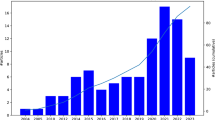Abstract
This work addresses the hub location problem with price-sensitive demands. The article analyzes sensitivity of demand to quality of service in such systems, and enables the solution of large-scale instances. Two distinct working formulations are provided, and an improved Benders decomposition algorithm is deployed. Simulation of consumer choice between competing services is addressed in the computational experiments. Further, a specialized sub-problem solution procedure which is able to deliver good Benders cuts in reasonable time is developed. The results are illustrated with standard test data sets. The research contributes to a better understanding of hub traffic with varying service levels, as well as price equilibrium in competitive markets.






Similar content being viewed by others
References
Beckmann MJ, McGuire CB, Winsten C (1956) Studies in the Economics of Transportation. Yale University Press, New Haven
Benders JF (1962) Partitioning procedures for solving mixed-integer programming problems. Numerisch Mathematik 4:238–252
Bruns A, Klose A, Stähly P (2000) Restructuring of Swiss parcel delivery services. OR Spektrum 22:285–302
Camargo RS, Miranda G (2012) Single allocation hub location problem under congestion: network owner and user perspectives. Expert Syst Appl 39(3):3385–3391
Camargo RS, Miranda G, Luna HP (2008) Benders decomposition for the uncapacitated multiple allocation hub location problem. Comput Oper Res 35:1047–1064
Camargo RS, Jr GM, Ferreira R, Luna H (2009a) Multiple allocation hub-and-spoke network design under hub congestion. Comput Oper Res 36(12):3097–3106
Camargo RS, Miranda G, Luna HP (2009b) Benders decomposition for hub location problems with economies of scale. Transp Sci 43:86–97
Campbell JF (1994a) Integer programming formulations of discrete hub location problems. Eur J Oper Res 72:387–405
Campbell JF (1994b) A survey of network hub location. Stud in Locational Anal 6:31–49
Campbell JF, O’Kelly ME (2012) Twenty-five years of hub location research. Transp Sci 46(2):153–169
Campbell JF, Ernst AT, Krishnamoorthy M (2002) Hub location problems. In: Drezner Z, Hamacher HW (eds) Facility location: applications and theory, 1st edn, Springer chap 12, pp. 373–407
Çetiner S, Sepil C, Süral (2010) Hubbing and postal routing in postal delivery systems. Ann Oper Res 181:109–124
Contreras I, Fernändez E, Marn A (2010) The tree of hubs location problem. Eur J Oper Res 202:390–400
Contreras I, Cordeau JF, Laporte G (2011a) Benders decomposition for large-scale uncapacitated hub location. Oper Res 59:1477–1490
Contreras I, Cordeau JF, Laporte G (2011b) Exact solution of large-scale hub location problems with multiple capacity levels. Transportation Science, To appear
Contreras I, Cordeau JF, Laporte G (2011c) Stochastic uncapacitated hub location. European Journal of Operational Research, To appear
Cordeau JF, Soumis F, Desrosiers J (2000) A Benders decomposition approach for the locomotive and car assignment problem. Transp Sci 34:133–149
Cordeau JF, Soumis F, Desrosiers J (2001) Simultaneous assignment of locomotives and cars to passenger trains. Oper Res 49(4):531–548
Cordeau JF, Pasin F, Solomon MM (2006) An integrated model for logistics network design. Ann Oper Res 144(1):59–82
Correia I, Nickel S, Saldanha-da Gama F (2013) Multi-product capacitated single-allocation hub location problems: Formulations and inequalities. Networks and Spatial Economics pp 1–25, doi:10.1007/s11067-013-9197-3
Dafermos SC, Nagurney A (1984) On some traffic equilibrium theory paradoxes. Transp Res B 18:101–110
Dafermos SC, Nagurney A (1985) Isomorphism between spatial price and traffic network equilibrium, LCDS #, pp. 85–17
Dafermos SC, Sparrow FT (1969) The traffic assignment problem for a general network. J Res Natl Bur Stand B 73:91–118
Elloumi S (2010) A tighter formulation of the p-median problem. J Comb Optim 19:69–83
Erlenkotter D (1977) Facility location with price sensitive demands: private, public and quasi-public. Manag Sci 24(4):378–386
Ernst AT, Krishnamoorthy M (1996) Efficient algorithms for the uncapacitated single allocation p-hub median problem. Locat Sci 4:139–154
Escudero L, Muñoz S (1998) On characterizing tighter formulations for 0-1 programs. Eur J Oper Res 106:172–176
Farahani RZ, Hekmatfar M, Arabani AB, Nikbakhsh E (2013) Hub location problems: a review of models, classification, solution techniques, and applications. Comput Ind Eng 64(4):1096–1109
Fischetti M, Salvagnin D, Zanette A (2010) A note on the selection of benders’ cuts. Math Program B 124:175–182
Friesz T, Tobin R, Smith T, Harker P (1983) A nonlinear complementarity formulation and solution procedure for the general derived demand network equilibrium problem. J Reg Sci 23(3):337–359
García-Bertrand R, Conejo A, Gabriel S (2005) Multi-period near-equilibrium in a pool-based electricity market including on/off decisions. Netw Spatial Econ 5:371–393
Geoffrion A (1972) Generalized Benders decomposition. J Optim Theory Appl 10(4):237–260
Geoffrion AM, Graves GW (1974) Multicomodity distribution system design by Benders decomposition. Manag Sci 20:822–844
Geromel J, Luna HPL (1981) Projection and duality techniques in economic equilibrium models. IEEE Trans Syst, Man Cybern 11:329–338
Gillen D, Oum TH, Tretheway M (1990) Airlines cost structure and policy implications. J Trans Eco and Policy 24:9–34
Grünert T, Sebastian HJ (2000) Planning models for long-haul operations of postal and express shipment companies. Eur J Oper Res 122(2):289–309
Han L, Zhang N (2013) P-hub airline network design incorporating interaction between elastic demand and network structure. Lect Notes Electr Eng 236:89–96
Hoang HH (2005) Topological optimization of networks: A nonlinear mixed integer model employing generalized benders decomposition. IEEE Transations Autom Control AC-27:164–169
Kara BY, Taner MR (2011) Foundations of Location Analysis, Hub Location Problems: The Location of Interacting Facilities. Springer, New-York
Kuby MJ, Gray RG (1993) The hub network design problem with stopovers and feeders: The case of federal express. Transp Res Part A: Policy Prac 27(1):1–12
Lederer P, Nambimadom R (1998) Airline network design. Oper Res 46(6):785–804
Lüer-Villagra AB, Marianov V (2013) A competitive hub location and pricing problem. Eur J Oper Res 231(3):734–744
Luna HPL (1978) Two-level national-regional planning and mathematical programming decomposition applied to spatial price equilibrium models. Socio-Enonomic Plan Sci 12:251–266
Luna HPL (1979) Note on price unicity in economic equilibrium models. Socio-Enonomic Plan Sci 13:223–225
Magnanti TL, Wong RT (1981) Accelerating benders decomposition: algorithmic enhancement and model selection criteria. Oper Res 29(3):464–483
Mahey P, Benchakroun A, Boyer F (2001) Capacity and flow assignment of data networks by generalized benders decomposition. J Glob Optim 20(2):169–189
McCusker S, Hobbs B (2003) A nested benders decomposition approach to locating distributed generation in a multiarea power system . Netw Spat Econ 3:197–223
McDaniel D, Devine M (1977) A modified Benders partitioning algorithm for mixed integer programming. Manag Sci 24(3):312–319
Mercier A, Cordeau JF, Soumis F (2005) A computational study of benders decomposition for the integrated aircraft routing and crew scheduling problem. Comput Oper Res 32(6):1451–1476
Metters RD (1996) Interdependent transportation and production activity at the united states postal service. J Oper Res Soc 47(1):27–37
Muoz E, Stolpe M (2011) Generalized benders’ decomposition for topology optimization problems. J Glob Optim 51(1):149–183
Nagurney A (1989) Migration equilibrium and variational inequalities. Econ Lett 31:109–112
Nagurney A (1999) Network economics: a variational inequality approach. Kluwer Academic Publishers, Dordrecht, The Netherlands
Nagurney A (2003) Some recente developments in network economics. Networks 41:68–72
Nagurney A (2004) A supply chain network equilibrium model with random demands. Eur J Oper Res 156:194–212
Nagurney A, Dong J (2002) Supernetworks: Decision-Making for the Information Age. Edward Elgar Publishers, Cheltenham, England
Nagy G, Salhi S (1998) The many-to-many location-routing problem. TOP 6:261–275
O’Kelly M (2010) Routing traffic at hub facilities. Netw Spat Econ 10:173–191
O’Kelly M (2014 ) Network hub structure and resilience. Networks and Spatial Economics To appear – Online First: doi:10.1007/s11067-014-9267-1
O’Kelly ME (1986) The location of interacting hub facilities. Transp Sci 20:92–106
O’Kelly ME (1987) A quadratic integer program for the location of interacting hub facilities. Eur J Oper Res 32:393–404
O’Kelly ME (1992) Hub facility location with fixed costs. Pap Reg Sci 71(3):293–306
O’Kelly ME, Miller HJ (1994) The hub network design problem: A review and synthesis. J Transp Geogr 2(1):31–40
Ouorou A, Luna HPL, Mahey P (2001) Multicommodity network expansion under elastic demands. Optim Eng 2(3):277–292
Papadakos N (2008) Practical enhancements to the MagnantiWong method. Oper Res Lett 36:444– 449
Parvaresh F, Golpayegany H, Husseini S, Karimi B (2013) Solving the p-hub median problem under intentional disruptions using simulated annealing. Netw Spat Econ 13:445–470
Randazzo C, Luna H (2001) A comparison of optimal methods for local access uncapacitated network design. Ann Oper Res 106:263–286
de Sá EM, Camargo RS, Miranda G (2013) An improven Benders decomposition algorithm for the tree of hubs location problem. Eur J Oper Res 226(4):185–202
Samuelson PA (1952) Spatial price equilibrium and linear programming. Am Econ Rev 42:283–303
Sheffi Y (1985) Urban Transportation Networks: Equilibrium Analysis with Mathematical Programming Methods. Prentice-Hall, Englewood Cliffs
Takayama T, Judge GG (1971) Spatial and Temporal Price and Allocation Models. North-Holland, Amsterdam
Wasner M, Zäpfel G (2004) An integrated multi-depot hublocation vehicle routing model for network planning of parcel service. Int J Prod Econ 90:403–419
Wilson R (1993) Nonlinear Pricing. Oxford University Press, New York
Zäpfel G, Wasner M (2002) Planning and optimization of hub-and-spoke transportation networks of cooperative third-party logistics providers. Int J Prod Econ 78(2):207–220
Zhao L, Dafermos SC (1991) General economic equilibrium and variational inequalities. Oper Res Lett 10:369–376
Acknowledgments
M. E. O’Kelly is grateful to The National Science Foundation (BCS-1125840) for support of current research on hub location models. R. S. de Camargo e G. de Miranda Jr. would like to thank the agencies CNPq and FAPEMIG for grants 202765/2013-0, 302986/2012-0, 479682/2012-7, 305446/2010-0, 402651/2012-0, 480295/2012-3 and 02357/2012 which partially supported this research.
Author information
Authors and Affiliations
Corresponding author
Appendix: A: Economic equilibrium conditions
Appendix: A: Economic equilibrium conditions
Considering formulation (1–13), for a given (fixed) state of the γ vector (γ=γ h), the resulting problem is searching for a maximization of a concave cost function subject to linear constraints. As the matrix W is assumed to be symmetric, the line integral in Eq. 1 is analytically tractable and the Karush-Kuhn-Tucker Conditions are are necessary and sufficient for a global optimum. Therefore, associating the dual variables u i j k ≥0, \(\ddot {\rho }_{ij} \geq 0\), \(\bar {\rho }_{ij} \geq 0\) and \(\tilde {\rho }_{ij} \geq 0\) respectively to constraints Eqs. 2, 3, 4 and 5, the following relations are verified at an optimal solution for each ij pair, provided that constraints Eqs. 2–13 are also satisfied
Note that at the optimal solution, for each l,k,m,k≠m such that \({\gamma _{l}^{h}} = {\gamma _{k}^{h}} = {\gamma _{m}^{h}} = 1\), complementary slackness conditions (50) will enforce u i j l =u i j k =u i j m =0, as required for an uncapacitated approach (b i j very large, not disturbing the economic equilibrium). Observing conditions (47–49), is straightforward to conclude that \(\tilde {\rho }_{ij} - \tilde {c}_{ij} = \bar {\rho }_{ij} - \bar {c}_{ijl} = \ddot {\rho }_{ij} - \ddot {c}_{ijkm} = 0 \).
Rights and permissions
About this article
Cite this article
O’Kelly, M.E., Luna, H.P.L., de Camargo, R.S. et al. Hub Location Problems with Price Sensitive Demands. Netw Spat Econ 15, 917–945 (2015). https://doi.org/10.1007/s11067-014-9276-0
Published:
Issue Date:
DOI: https://doi.org/10.1007/s11067-014-9276-0




